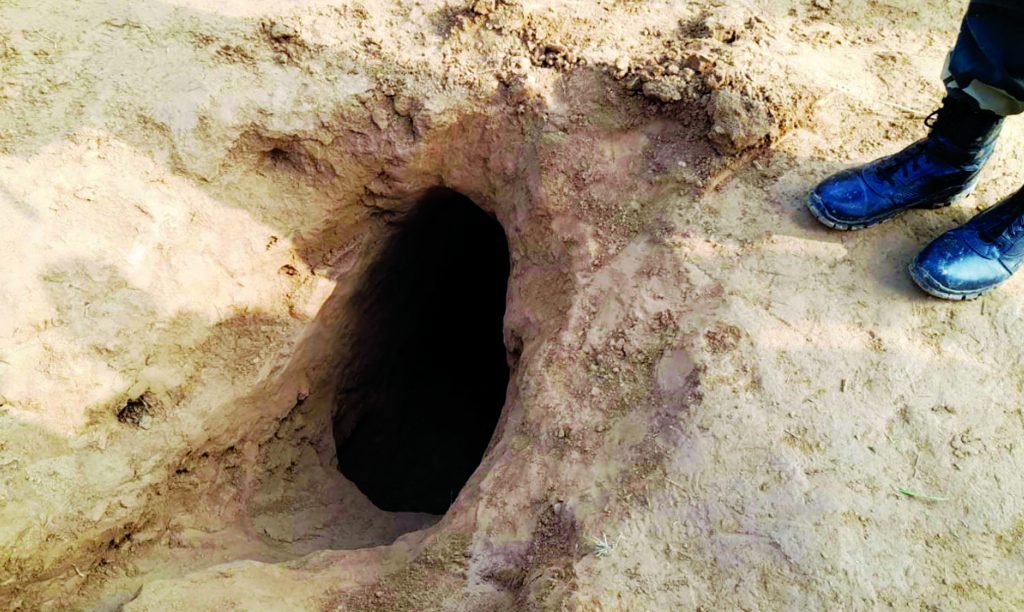NEW DELHI, Jan 23: The Border Security Force has decided to further intensify the search on the borders with Pakistan in Jammu and Kashmir sector to look for underground tunnels built across the line allegedly with the help of Pakistani army to facilitate infiltration of terrorists into the country.
The decision was reportedly taken after detection by the BSF of one more secret tunnel on Saturday, the second within the last 10 days, in Kathua district in Jammu and Kashmir. The intelligence officials believe that the Pakistan deep state had created a web of tunnels at various points across the border to push in terrorists inside the country nullifying deployment of forces to guard the border.
On Saturday, the BSF found a 150-metre long underground tunnel, the second one to be spotted in the last 10 days. The 30-feet deep tunnel has been detected between Border Post number 14 and 15 near BSF’s outpost at Pansar, Kathua district. On the other side of the fence are Pakistani border outposts of Abhiyal Dogra and Kingre-de-Kothe in Shakargarh district.
The secret tunnel was detected during an anti-tunnelling operation in the border outpost Pansar area of Hiranagar sector, an official spokesman of the BSF said. This is the second underground tunnel detected by BSF personnel in Hiranagar sector during the past 10 days, fourth in the past six months along the IB in Samba and Kathua districts and 10th in the past decade.
On January 13, a 150-metre-long tunnel was detected in Bobiyaan village in the same sector.
Pakistan’s Shakargarh, the area across the fence, is home to a terror training facility overseen by one of Jaish-e-Mohammed’s operational commander Kasim Jan who, Indian intelligence believes, was involved in the November 19 Nagrota encounter in Jammu and is the principal accused in the 2016 Pathankot airbase attack. Jan is also one of the main launch commanders of Jaish terrorists into India.
“This is huge,” a senior BSF official said. Because the tunnel appears to be at least 6 to 8 years old and would have been used for infiltration for a long time. Also, it is located in a place that has seen action in the past, right from 2012 when Pakistan had mounted a heavy fire assault on the forward duty point and constructed a new bunker on the zero line in the vicinity.
Not far from where the tunnel was found, a BSF assistant commandant Vinay Prasad who was leading a border domination patrol was killed by sniper fire from across the border in January 2019. Ten months later, a group of terrorists was noticed in the same area in November 2019.
“It is very important to detect all the tunnels built by the Pakistani military and its terrorists because the infiltration of terrorists through them practically nullifies the utility of deployment of soldiers along the Line of Control. When it becomes too difficult to cross the LoC, Pakistani terrorists use these tunnels,” a senior counterterror official said.
The BSF director general Rakesh Asthana had ordered an intensive search to detect tunnels across the border after the Nagrota encounter in November in which four terrorists were killed and the security forces was able to detect the route they had used to sneak into India, an underground tunnel.
Security officials underscore that proper engineering effort had gone into the construction of the tunnels that had been detected in recent times, pointing to the involvement of the Pakistani military along the heavily-guarded border.
Meanwhile, the BSF carried out an intelligence-backed raid in Poonch district that led to the seizure of one AK-47 rifle, three China-made pistols, an under-barrel grenade launder and a radio set.
(Manas Dasgupta)

